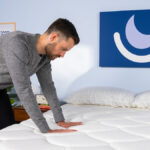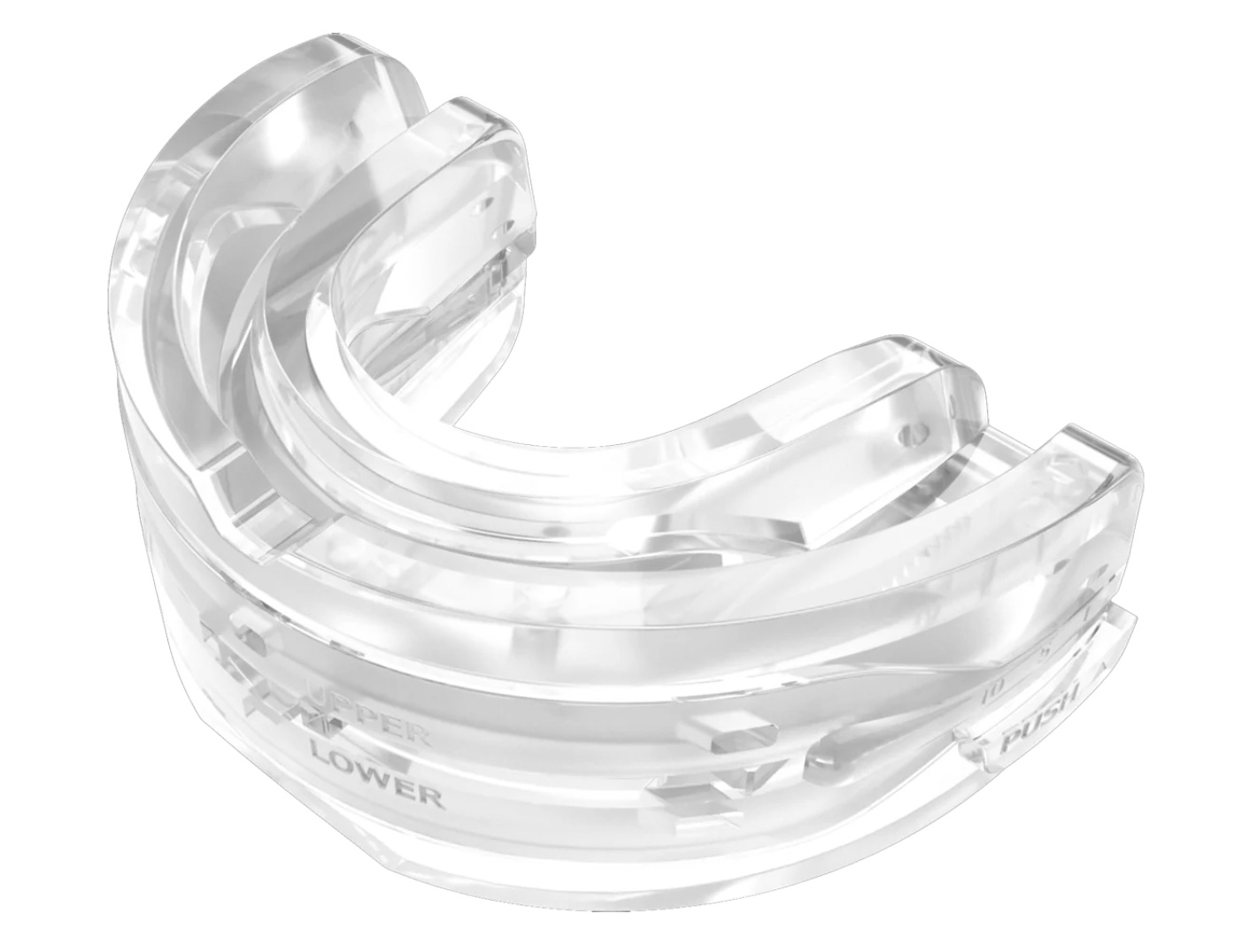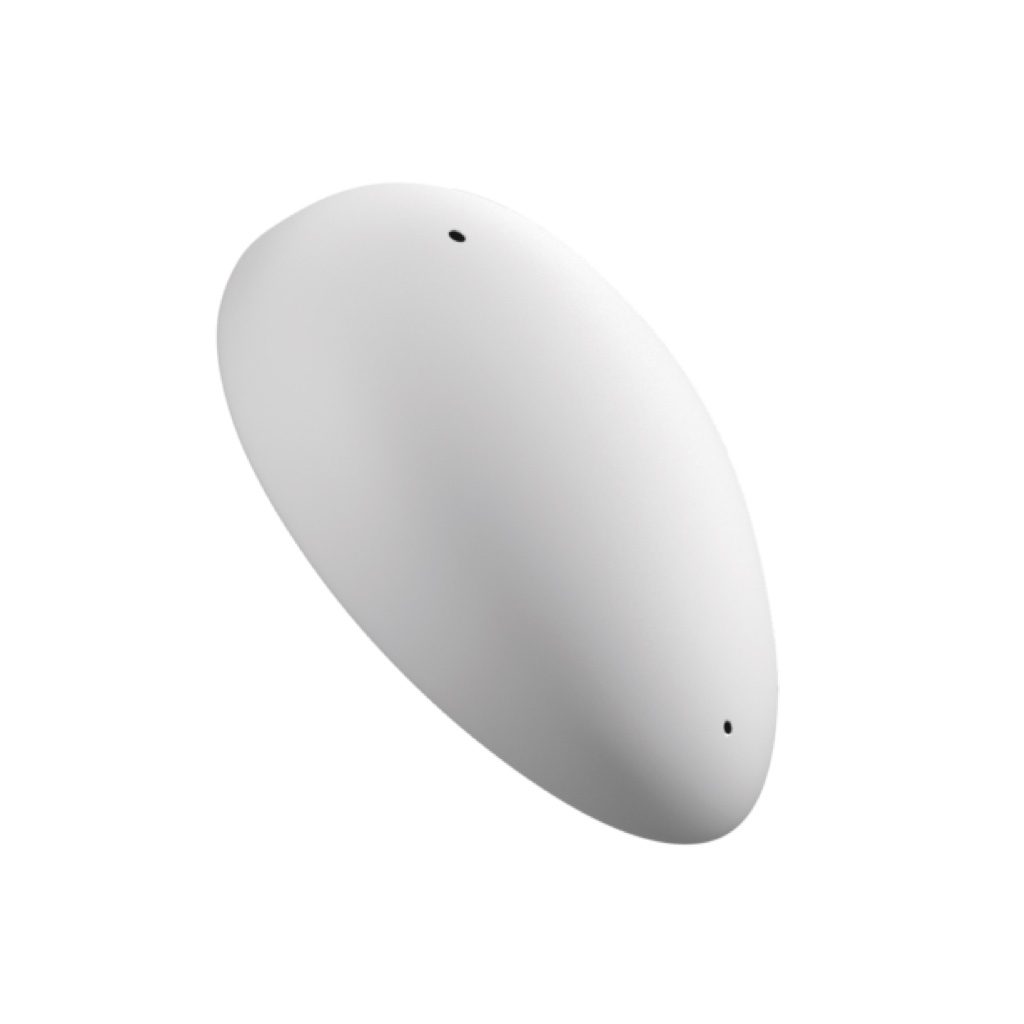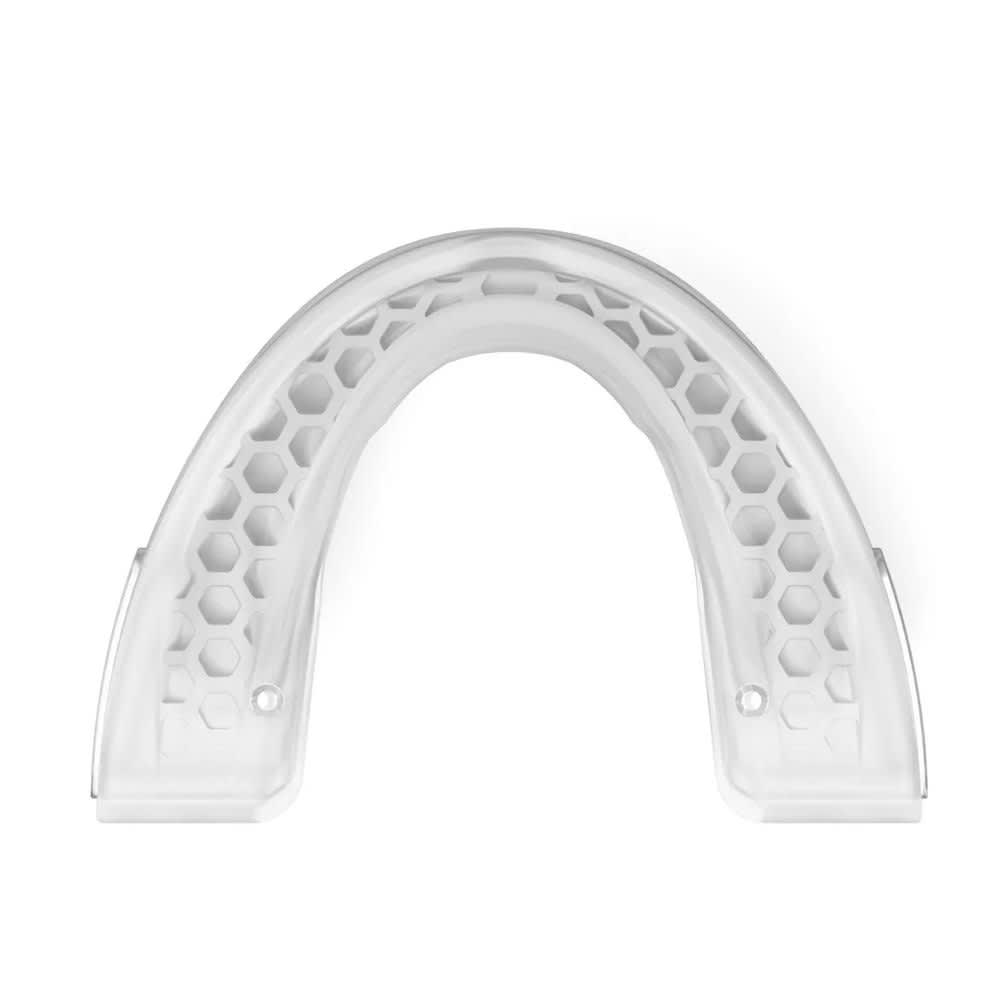Medical Disclaimer: The following content should not be used as medical advice or as a recommendation for any specific supplement or medication. It is important to consult your health care provider prior to starting a new medication or altering your current dosage.
CareFusion ApneaRx Sleep Apnea Mouthpiece
The CareFusion ApneaRx Sleep Apnea Mouthpiece features a highly customizable design. The boil-and-bite template adapts to your teeth, while a user-friendly tab allows you to adjust the lower jaw position in 1-millimeter increments.
Snoring occurs when a person’s airway narrows during sleep, partially obstructing the flow of air and causing soft tissues to vibrate. The noise can disrupt sleep for a bed partner and sometimes awaken the person snoring.
Many people find that anti-snoring mouthpieces are a simple, affordable way to stop snoring. Mandibular advancement devices (MADs) push the lower jaw forward to keep the airway open, while tongue-retaining devices (TRDs) anchor the tongue to prevent it from slipping back.
We’ll explore the best anti-snoring mouthpieces and mouthguards and discuss how to know if an anti-snoring device is right for you.
Looking for more snoring solutions? See our guide to the best mattresses for snoring. You may also find relief with one of the best pillows for snoring.
Amazon Prime Day Is Almost Here!
Amazon Prime Day 2024 will take place Tuesday, July 16th, and Wednesday, July 17th. Many leading mattress and bedding brands are offering sales and discounts of their own during this time. Check out our guide to Amazon Prime Day Mattress Sales for details about all the best deals.
Sleep Doctor’s Picks
Best Overall
CareFusion ApneaRx Sleep Apnea Appliance
Details
Mouthpiece Type: Mandibular advancement device (MAD)
Price: $199
Pros
- Simple boil-and-bite customization process
- Adjustable in 1mm increments for a optimal comfort
- Can effectively treat snoring related to mild to moderate OSA
Cons
- Expensive pricing compared to the competition
- Not suitable for people with dental problems or TMJ
The CareFusion ApneaRx Sleep Apnea Mouthpiece is both customizable and adjustable, helping to ensure a comfortable fit for most wearers.
Why We Like It
You can prepare the device at home using an easy boil-and-bite method. This creates a mold that aligns with your unique dental patterns. The mouthpiece can be moved forward up to 10 millimeters in 1-millimeter increments. Finding your most comfortable level may require some trial and error, but this adjustment range should suit most people regardless of how mandibular advancement they need.
How Does It Work?
As an MAD, the ApneaRx physically moves your jaw forward to expand your breathing passages and reduce snoring. A small opening at the front of the device helps promote extra airflow. A storage case and instruction manual are included with your purchase. Daily cleaning is recommended to keep the mouthpiece hygienic.
The CareFusion ApneaRx Sleep Apnea Mouthpiece is somewhat expensive compared to other MADs on the market. That said, your insurance provider may reimburse some or all of the cost of your purchase.
Best Adjustable
SnoreRx Mouthpiece
Details
Mouthpiece Type: Mandibular advancement device (MAD)
Price: $60
Pros
- Users can make ongoing adjustments to jaw positioning
- Easy-to-use boil-and-bite design
- Competitive price-point
Cons
- Only comes in one size
- Some users may experience jaw or dental discomfort, especially at first
The SnoreRx checks a lot of boxes for people in search of a comfortable anti-snoring mouthguard. The device is easy to customize, fully adjustable, conducive to mouth breathing, and affordable.
Why We Like It
For added comfort, the SnoreRx is soft, pliable, and lightweight. Small ventilation holes promote airflow while you sleep, allowing you to breathe through your mouth without obstruction. The device is adjustable in increments of 1 millimeters up to 6 millimeters, allowing for full lateral movement. This is a major perk for anyone who has found other mouthpieces too restrictive.
How Does It Work?
The SnoreRx Mouthpiece is a fully customizable mandibular advancement device designed to curb snoring by repositioning your jaw. The boil-and-bite design allows you to easily make an impression that’s custom-fitted for your mouth. After the impression has been made, you can adjust how far the guard pushes your jaw forward.
Customizing the SnoreRx is an easy, straightforward process. Bring a glass of water to a boil in a microwave, and then dip the SnoreRx in the glass for exactly two minutes. Then remove the mouthguard and immediately dip it in a glass of cold water. Wait a few seconds, then take the mouthguard out of the water, place it in your mouth, and bite down for three minutes. Lastly, remove the device from your mouth and soak it in the glass of cold water for 10 minutes to allow it to set. Don’t worry if the impression isn’t a perfect fit after the first setting — you can attempt a second impression if needed.
Best Value
Sleepon M2 Anti-Snoring Mouthpiece
Details
Mouthpiece Type: Mandibular advancement device (MAD)
Price: $40
Pros
- Adjustable design lets you pinpoint your most comfortable advancement level
- Customizable using the easy boil-and-bite method
- Device can also minimize clenching and grinding of teeth
Cons
- People with loose teeth and gum disease need a different solution
- Long-term use can cause jaw pain
Priced much lower than the average MAD, the Sleepon M2 is an effective anti-snoring mouthpiece that can also reduce teeth clenching and grinding. This device can also be customized using boil-and-bite trays and easily adjusted without extra tools.
Why We Like It
High-quality MADs rarely match the accessible sticker price of the Sleepon M2. We also like this device for its straightforward customization — simply boil the upper and lower trays, then bite down on the molding. You can repeat this process if you don’t get it right the first time. Once the mouthpiece is ready for use, you can nail down your ideal advancement level. The lower tray can be moved forward up to 10 millimeters in 1-millimeter increments.
How Does It Work?
As with other MADs, the M2 works by physically advancing your lower jaw and opening up your throat — extra airflow helps to minimize snoring caused by OSA. After using the device over time, you may notice less daytime sleepiness. The mouthpiece also protects your teeth from damage related to frequent clenching or grinding while you sleep. Daily cleaning is required to keep the device clean. Brushes and a storage case are included with each purchase.
Best for People with Sleep Apnea
American Sleep Dentistry Oral Appliance
Details
Mouthpiece Type: Mandibular advancement device (MAD)
Price: $1295
Pros
- Mouthpiece is fitted in a lab to ensure high-quality customization
- Device has been FDA-cleared for OSA treatment
- Daily cleaning is a quick, straightforward process
Cons
- Jaw pain may occur
- Much more expensive than the average anti-snoring mouthpiece
Not all people who snore have sleep apnea, but OSA is a leading cause of heavy snoring and people who have been diagnosed with this sleep disorder often benefit from using a specialized mouthpiece. The American Sleep Dentistry Oral Appliance is one of the most advanced MADs on the market — you’ll pay a premium price for the device, but people who snore due to sleep apnea should see major results.
Why We Like It
The Oral Appliance is crafted in a lab using a mold from your upper and lower teeth. This ensures a fully customized fit based on your unique dental patterns. You’ll work with one of American Sleep Dentistry’s Medicare-credentialed dentists throughout this process. The mouthpiece is quite expensive, but this extra step means your insurance may cover most — or even all — of the purchase price.
How Does It Work?
The Oral Appliance advances your jaw forward to expand your airway and promote comfortable breathing, which in turn can cut down on snoring. Hinges on both sides allow you to adjust the advancement based on your comfort needs. This device has been FDA-cleared for as a treatment method for OSA-related snoring.
Best Tongue Stabilizer
Good Morning Snore Solution
Details
Mouthpiece Type: Tongue retaining device (TRD)
Price: $100
Pros
- Simple suction holds tongue forward with no need for custom fitting
- Doesn’t affect teeth or jaw placement, so it’s less likely to cause morning pain
- Minimalist design works with dentures
Cons
- Limits mouth movement
- Tongue may not stay attached when the device is wet
The Good Morning Snore Solution’s unobtrusive design is ideal for anyone who can’t use MADs due to their medical or dental history. Easy application and a lightweight design make the device a hassle-free alternative to traditional mouthguards.
Why We Like It
The Good Morning Snore Solution is optimal for sleepers who cannot use MADs. These include people with medical conditions such as temporomandibular disorders (TMDs) and advanced gum disease, as well as those with dentures, braces, and dental implants. No boiling or molding is needed, as this mouthguard offers a universal fit.
Good Morning Snore Solution frequently offers promotions that include two or even four mouthguards for the price of one, allowing you to save a lot of money on your purchase.
How Does It Work?
Applying the Good Morning Snore Solution is a quick and painless process. Simply place the device’s flanges between your lips and teeth or dentures, squeeze the bulb between your fingers while inhaling, and insert your tongue into your bulb. The pliable, pear-shaped device uses gentle suction to pull the tongue forward to open up your breathing passages. You may need a few nights to get used to swallowing with the device in place. In the morning, squeeze the bulb and your tongue should slide out easily.
Best Device
Smart Nora
Details
-
Price: $359
Pros
- Noninvasive design may appeal to those who prefer not to wear a mouthpiece
- Compatible with most pillow types and all sleeping positions
- Customizable sensitivity and inflation settings
Cons
- Higher price-point compared with over-the-counter mouthguards
- Requires batteries and cables to operate
Anti-snoring mouthguards have proven to be effective for many sleepers, but some find them uncomfortable and restrictive. If you fall into the latter group, then you’re a prime candidate for the Smart Nora.
Why We Like It
The Smart Nora is virtually silent and does not require a mouthguard of any kind. The device is also compatible with side, back, or stomach sleeping. Additionally, you can adjust the Pebble’s sensitivity level to detect light and heavy snoring. Each component is lightweight and compact, so the Smart Nora doubles as a travel-friendly anti-snoring aid.
The Smart Nora’s expensive price-point reflects its cutting-edge design, but this device may be a solid investment if you are losing sleep from snoring and mouthguards haven’t been helpful.
How Does It Work?
This innovative device consists of three components. First there’s the Pebble, a small device resembling a computer mouse that rests on your nightstand and monitors your breathing patterns using smart technology. You’ll also receive an insert for your pillow and an air pump that rests beside your bed on the floor. If the Pebble detects snoring, the pump will inflate the insert to elevate your head and open up your breathing passages.
Is an Anti-Snoring Mouthpiece Right for You?
An anti-snoring mouthpiece might be right for you if you experience simple snoring with no other symptoms. These devices are generally affordable and easy to source. Additionally, anti-snoring mouthpieces are often available without a prescription.
Anti-snoring devices do come with some potential side effects, most notably drooling and jaw discomfort as you adjust to the mouthpiece. If these side effects bother you, you may prefer other methods to reduce snoring.
You may not be able to wear an anti-snoring mouthpiece if you’ve had recent dental work, if you’re missing teeth, if you have a large overbite, or if you wear braces, a retainer, or dentures. Conditions such as asthma, central sleep apnea, periodontal disease, or chronic jaw pain may also make it unwise to use an anti-snoring mouthpiece.
How Do They Work?
The sound of snoring occurs when muscles relax during sleep and allow soft tissues to block the airway, causing audible vibrations as air works to pass through the smaller space. Anti-snoring mouthpieces widen the airway by either forcing the lower jaw forward or holding the tongue in place.
Types of Anti-Snoring Mouthpieces
The two primary types of anti-snoring mouthpieces are mandibular advancement devices and tongue-retaining devices.
Mandibular Advancement Devices (MADs)
Snoring is often triggered by the lower jaw, or mandible, slipping backward during sleep. Mandibular advancement devices work by bringing the lower jaw forward to keep the airway open. These devices typically use a boil-and-bite process to mold the device to your teeth. MADs may be especially effective if your snoring is at its worst when lying on your back.
MADs can be uncomfortable at first. Some users may experience dry mouth, drooling, or tooth and gum pain. However, many people find that these side effects improve after several weeks.
Tongue-Retaining Devices (TRDs)
Tongue-retaining devices work to keep the airway open by either holding the tongue down with prongs or pulling it forward using gentle suction to prevent it from falling back and blocking the throat.
TRDs are less popular than MADs, but some people prefer TRDs because they don’t exert as much pressure on the teeth and jawbone. As with many MADs, mouth movements may be limited when wearing a TRD. Some users may experience soreness in the tongue, teeth, or gums when they first start using the device.
Video: How You Can Stop Snoring
Watch our video to learn more about snoring, what causes it, and tips for stopping it.
How to Choose an Anti-Snoring Mouthpiece
Anti-snoring mouthpieces from different manufacturers may look similar, but subtle differences in design and materials can impact how comfortable and effective they are.
Adjustability and Customization
Most MADs can be customized to fit your teeth using the boil-and-bite method, similar to a sports mouthguard. Some models also allow you to slide the lower jaw forward in small increments until you find a position that keeps your airway open without feeling too uncomfortable. It may take a few days to adjust to each change.
TRDs are less often customizable, although they may come in different sizes.
Comfort
It can feel uncomfortable to wear a mouthpiece, especially if it’s bulky or if the edges or screws chafe against the inside of your mouth. You can reduce discomfort by selecting a model made with soft materials in a size that fits comfortably inside your mouth.
It may help to start by wearing your new device for short periods during the day. After the initial adjustment period, most sleepers grow accustomed to the feel of the mouthguard and no longer experience significant side effects.
Some, but not all, mouthpieces leave a small opening in case you need to breathe through your mouth. You may find it helpful to use a mouth lubricant if your mouthguard prevents you from fully closing your mouth during sleep. If you have trouble with the mouthpiece falling out, try using a chin strap.
Quality
MADs and TRDs are typically made of medical-grade thermoplastic, which can be molded to eliminate sharp edges and fit the shape of your mouth. This material is resistant to wear and tear, and the best anti-snoring mouthguards are reinforced with extra layers or extra-strong hinges to hold up better against jaw clenching and tooth grinding.
Tongue-retaining devices may be made of softer materials like silicone. Manufacturers usually take care to avoid harmful materials like bisphenol A (BPA) or allergens such as latex, but it’s a good idea to verify the materials before purchasing.
Ease of Cleaning
Anti-snoring mouthpieces need daily cleaning. Most devices can be cleaned with a toothbrush, toothpaste, and warm water. If ease of maintenance is an important factor for you, bear in mind that models with hinges or other extra parts may be more difficult to keep clean.
Pricing
The average cost of an over-the-counter MAD or TRD lies between $50 and $100, with some manufacturers offering subscription plans at a discounted price. Higher-priced models may offer more customization options or better-quality materials. Expect to pay much more for a custom-fitted, medical-grade mouthpiece from a dentist.
Prescription Requirements and Insurance Coverage
Anti-snoring mouthpieces are widely available online and in stores with no need for a prescription. You may also be able to obtain a mouthpiece through your dentist or doctor.
Over-the-counter mouthpieces used for snoring generally do not qualify for insurance coverage, although you may be able to use a flexible spending account or health savings account to defray the cost.
Medicare offers coverage for certain oral appliances if they are used to treat obstructive sleep apnea (OSA), in which case you’ll need a prescription and you’ll need to fulfill the Medicare requirements.
Trial and Warranty
Manufacturers may offer a short trial period, typically between 30 and 60 nights, so you can try out the mouthpiece and return it for a refund if it doesn’t work for you. Since anti-snoring mouthpieces fit each person differently, this trial period can be useful when deciding between models. Keep in mind that you may not qualify for the trial if you buy through a third-party seller.
Mouthpieces may also be covered by a warranty against defects in materials and workmanship.
Frequently Asked Questions
Limited research suggests that anti-snoring mouthpieces can effectively reduce snoring for many people. However, since the reasons for snoring vary from person to person, you may find that some trial and error is needed before finding a solution that works for you.
Anti-snoring mouthpieces are generally considered safe for use by people over 18 years old. They’re designed to be too big to swallow or choke on, and they don’t pose any direct danger to the upper airway. However, it’s a good idea to talk to your dentist before using one, as they may move the position of your jaw or teeth.
If you have a medical condition such as central sleep apnea, a respiratory disorder, dental or jaw problems, or if you wear a dental device, you should consult with your doctor or dentist, as it may not be safe for you to wear a mouthguard. Anti-snoring mouthpieces sold over the counter aren’t intended to treat teeth grinding or sleep apnea, and they shouldn’t be considered a substitute for medical treatment of these conditions.
When choosing an anti-snoring mouthpiece, look for reputable brands that are cleared for treating snoring by the Food and Drug Administration.
The expected lifespan of an anti-snoring mouthpiece can range from two months up to three years, depending on the materials and how well it’s maintained. You may wear down your mouthpiece sooner if you grind your teeth or clench your jaw.
If you have symptoms of obstructive sleep apnea such as daytime sleepiness or waking up gasping for air, you should not attempt to self-treat the condition with an anti-snoring mouthpiece. Although these devices may help reduce snoring, which is a common symptom of OSA, it’s important to get proper medical treatment to avoid long-term health impacts.
Over-the-counter anti-snoring mouthpieces differ from oral appliances specifically designed to treat sleep apnea. The latter devices require a prescription following an OSA diagnosis.
Most mouthpieces can be gently cleaned with a soft toothbrush and a mild soap or nonabrasive toothpaste. Avoid using hot water. Check the user guide for specific instructions on cleaning solutions that are safe to use with your device.
You should clean the mouthpiece every time you take it out of your mouth, let it dry, and store it in its case. To keep your mouthpiece clean, always brush your teeth before inserting the device.
While anti-snoring mouthpieces can be an effective treatment option for snoring, many people find they can reduce snoring and also improve their overall health with lifestyle changes, such as losing weight and avoiding alcohol or sedatives before bed. Propping up the head of the bed with an adjustable base may also reduce snoring. Some people find that using a specially designed pillow, such as a wedge pillow, helps with snoring.
For snoring that worsens during allergy season, it may be helpful to use nasal sprays to clear your nasal passages. Speak with your doctor if you have concerns about your snoring, as it may be a sign of a more serious health condition.
Ask the Sleep Doctor
Have questions about sleep? Submit them here! We use your questions to help us decide topics for articles, videos, and newsletters. We try to answer as many questions as possible. You can also send us an email. Please note, we cannot provide specific medical advice, and always recommend you contact your doctor for any medical matters.










